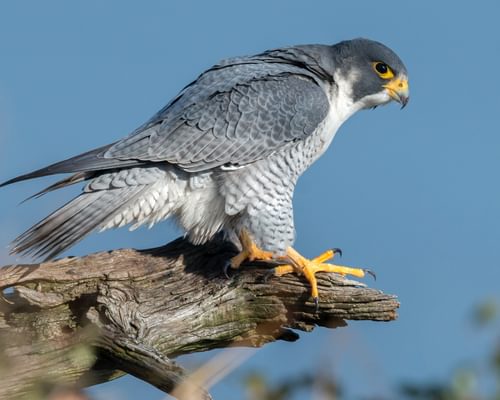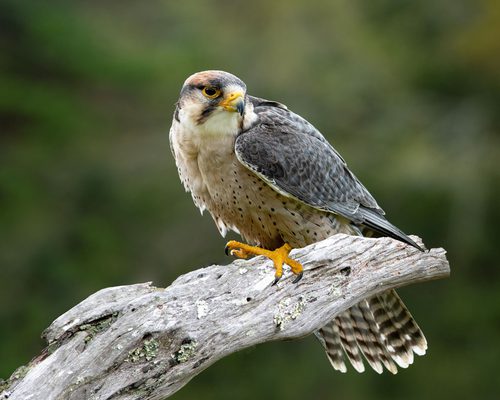Saker Falcon
EndangeredFalco cherrug
Visual Identification
Appearance
The Saker Falcon is a large, powerful raptor with a robust build. Its upper parts are predominantly brown with pale edges, while the underparts are lighter, often buff-coloured with dark streaks. The head features a pale crown and a distinctive 'moustache' marking.
Females are noticeably larger than males, with broader wings and a heavier build. Juveniles have more pronounced streaking on their underparts and a bluish cere and eye-ring, which turn yellow in adults.
Size
Length
45cm to 57cm
Wingspan
97cm to 126cm
Weight
730g to 1.3kg
Colours
Males and females have similar plumage
Primary Colour
Brown Grey
Secondary Colour
White Buff
Beak Colour
Grey Blue
Leg Colour
Yellow
Habitat and Distribution
Habitats
Woodland
Garden
Wetland
Coastal
Urban
Farmland
Grassland
Desert
Tundra
Rainforest
Mountain
Savanna
Distribution
Saker Falcons inhabit wide-open landscapes, including steppes, grasslands, and semi-deserts across a vast range from Eastern Europe to Central Asia. They prefer areas with sparse vegetation and elevated perches for hunting.
During winter, some populations migrate south to warmer regions, including parts of the Middle East and North Africa. They are occasionally spotted as rare vagrants in the UK.
Elevation Range
Up to 4,700 meters
Climate zones
Temperate, Subtropical, Arid
Distribution Map
This map gives you a rough idea of where you might spot a Saker Falcon. The coloured areas show countries where these birds have been seen.
A few things to keep in mind:
- Birds might not be everywhere in the coloured areas, for example, they may be present around the coast of that country
- Where birds live can change with seasons and available food
- This map is quite simple - it doesn't show exact locations
We're working on making our maps even better! Soon, we hope to show you:
- More detailed maps for bigger countries, including state and region
- How birds move around during different seasons
Distribution by Region
Behaviour and Ecology
Bird Attributes
This feature is in beta. We'd love your feedback to improve it!
Share your thoughtsBird Attributes Explained
Our bird attributes system rates various aspects of a bird's capabilities on a scale of 0-100, based on data from field observations, scientific studies, and expert knowledge.
Attribute Categories:
- Agility: Manoeuvrability, speed, and grace in flight or movement.
- Strength: Physical power, often correlating with size and hunting abilities.
- Adaptability: Ability to thrive in various environments or changing conditions.
- Aggressiveness: Territorial behaviour and assertiveness, particularly during breeding seasons.
- Endurance: Stamina, often seen in migration patterns or foraging behaviours.
Understanding the Ratings:
- 0-20: Very Low
- 21-40: Low
- 41-60: Average
- 61-80: High
- 81-100: Very High
Remember, these attributes are relative to other bird species and don't necessarily indicate superiority.
Hover over the icon next to each attribute for more information.
Tap the icon next to each attribute for more information.
Agility
Reflects the bird's manoeuvrability, speed, and grace in flight or movement.
The Saker Falcon demonstrates exceptional agility, capable of swift, powerful flight and impressive aerial hunting skills. Their ability to perform high-speed chases and mock attacks during breeding displays further showcases their remarkable manoeuvrability.
Strength
Indicates the bird's physical power, often correlating with size and hunting abilities.
As a large, robust raptor, the Saker Falcon possesses considerable strength. Their powerful build and ability to catch medium-sized mammals and birds indicate significant physical prowess, essential for their predatory lifestyle.
Adaptability
Represents the bird's ability to thrive in various environments or changing conditions.
Saker Falcons show good adaptability, inhabiting various open landscapes from steppes to semi-deserts across a vast range. Their ability to utilise artificial structures like power lines for perching demonstrates some flexibility in adapting to human-altered environments.
Aggressiveness
Measures the bird's territorial behaviour and assertiveness, particularly during breeding seasons.
While not overly aggressive towards humans, Saker Falcons exhibit strong predatory behaviour and territorial instincts during breeding season. Their hunting techniques, involving high-speed pursuits and surprise attacks, reflect a moderate to high level of aggression towards prey.
Endurance
Reflects the bird's stamina, often seen in migration patterns or foraging behaviours.
The Saker Falcon's endurance is impressive, evidenced by their ability to perform long hunting flights and their partial migratory nature. Their capacity to inhabit high-elevation areas up to 4,700 metres also suggests considerable stamina and physiological resilience.
Diet
Saker Falcons primarily feed on small to medium-sized mammals, particularly ground squirrels and hares. They also hunt birds, including pigeons and partridges.
These falcons employ a combination of high-speed chases and surprise attacks to catch their prey, often pursuing them close to the ground.
Behaviour
Saker Falcons are known for their swift, powerful flight and impressive aerial hunting skills. They often hunt close to the ground, using their speed and agility to catch prey.
During the breeding season, pairs engage in spectacular aerial displays, including high-speed chases and mock attacks.
Vocalisation
Saker Falcons are generally quiet outside the breeding season. During courtship and nesting, they produce a series of loud, harsh 'kree-kree-kree' or 'kek-kek-kek' calls. These vocalisations are often heard during territorial displays or when alarmed.
Nesting & Breeding
Saker Falcons typically breed between March and June. They form monogamous pairs and often reuse nesting sites from previous years. These falcons do not build their own nests but utilise abandoned nests of other large birds or cliff ledges.
Females lay 3-5 eggs, which are creamy-white with reddish-brown markings. The eggs are incubated primarily by the female for about 30-32 days while the male provides food.
Chicks fledge after 45-50 days but remain dependent on their parents for several weeks afterwards, gradually developing their hunting skills.
Lifespan
The Saker Falcon typically lives for 5 to 7 years, with a maximum recorded lifespan of 15.9 years.
Like all birds, lifespan can be affected by factors including predation, habitat quality, disease, and access to food sources.
Conservation and Status
Global Conservation Status
The Saker Falcon faces significant threats due to habitat loss, electrocution on power lines, and illegal capture for falconry.
Conservation efforts focus on habitat protection, artificial nest provision, and stricter trade regulation. Captive breeding programs aim to bolster wild populations in some regions.
Birdwatching Tips
- Look for Saker Falcons in open landscapes, especially grasslands and steppes
- Observe power lines and poles, which they often use as perches
- Listen for their loud, raspy calls during breeding season
- Watch for their distinctive hunting behaviour close to the ground
Additional Information
Quick Facts
Other names:
Saker
Family:
FalconidaePredators
Adult Saker Falcons have few natural predators, but their eggs and chicks are vulnerable to large owls, ravens, and climbing mammals.
Did You Know?
- Saker Falcons can reach speeds of up to 200 mph (321 km/h) in a hunting dive.
- They have been used in falconry for over 3,000 years.
- Their name comes from the Arabic 'saqr', meaning falcon.
- They are thought to be able to possibly live for 20-25 years, and there are even reports that they can live for up to 29 years. However, these have not been confirmed.
Was this bird profile helpful?
Your feedback helps us improve our content
Thanks for your feedback!
Your input helps us improve our content.
Community Experience
Community Ratings
No ratings yet - be the first to rate this bird!
Latest Community Reviews
No reviews yet
Sign in to be the first to review
Community Reviews
Create Your Free Account Welcome Back!
Join our community to rate birds and share your experiences. Creating an account is completely free and only takes a minute. Sign in to your account to rate birds and share your experiences with our community.
Your information is secure and will never be shared.
By creating an account, you agree to our Privacy Policy.
Similar Birds
References
- 2 4
website: BirdLife International. 2021. Falco cherrug. The IUCN Red List of Threatened Species 2021: e.T22696495A204182473.
View source - 3
report, 2014: Saker Falcon Action Plan, Kovács et al.
- 1
website, 2010: Fransson et al., EURING list of longevity records for European birds
View source

